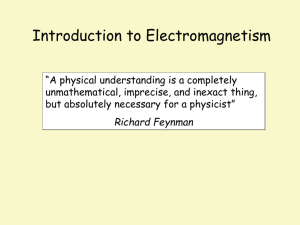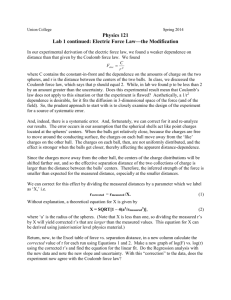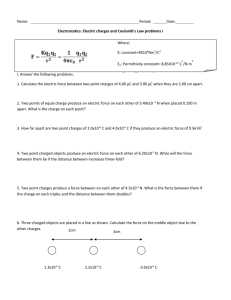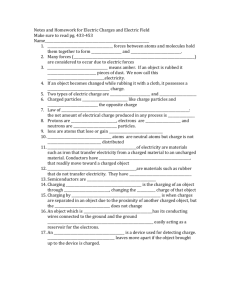Coulomb's Law Problems
advertisement
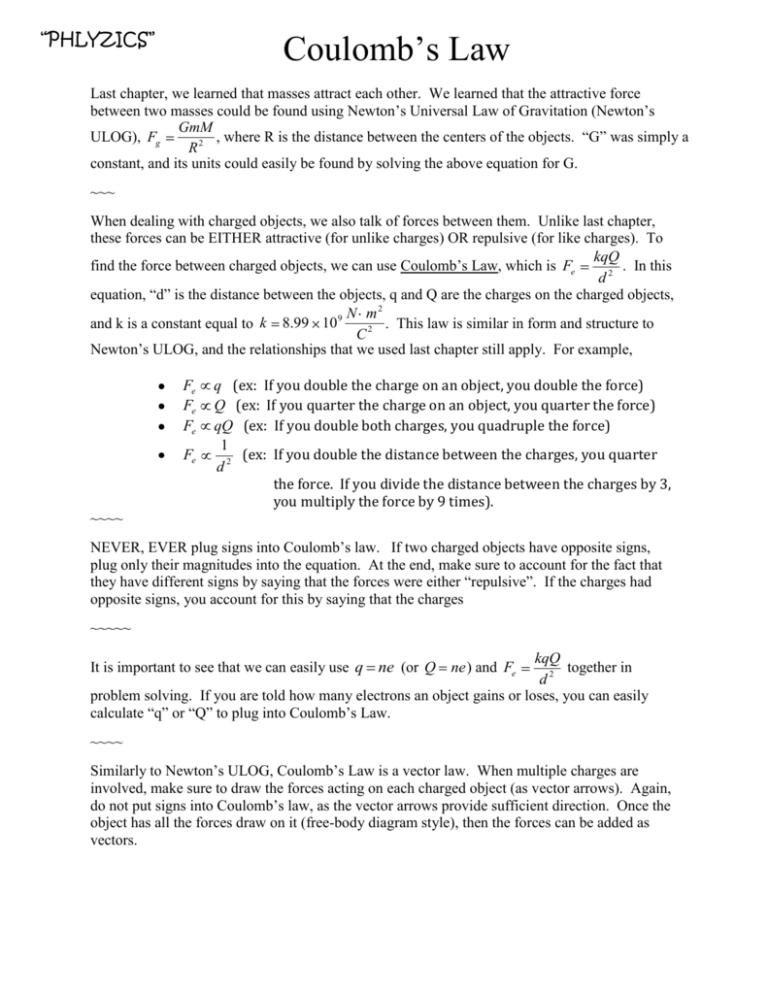
“PHLYZICS” Coulomb’s Law Last chapter, we learned that masses attract each other. We learned that the attractive force between two masses could be found using Newton’s Universal Law of Gravitation (Newton’s GmM ULOG), Fg , where R is the distance between the centers of the objects. “G” was simply a R2 constant, and its units could easily be found by solving the above equation for G. ~~~ When dealing with charged objects, we also talk of forces between them. Unlike last chapter, these forces can be EITHER attractive (for unlike charges) OR repulsive (for like charges). To kqQ find the force between charged objects, we can use Coulomb’s Law, which is Fe . In this d2 equation, “d” is the distance between the objects, q and Q are the charges on the charged objects, N m2 and k is a constant equal to k 8.99 10 9 . This law is similar in form and structure to C2 Newton’s ULOG, and the relationships that we used last chapter still apply. For example, Fe Fe Fe Fe q (ex: If you double the charge on an object, you double the force) Q (ex: If you quarter the charge on an object, you quarter the force) qQ (ex: If you double both charges, you quadruple the force) 1 (ex: If you double the distance between the charges, you quarter d2 the force. If you divide the distance between the charges by 3, you multiply the force by 9 times). ~~~~ NEVER, EVER plug signs into Coulomb’s law. If two charged objects have opposite signs, plug only their magnitudes into the equation. At the end, make sure to account for the fact that they have different signs by saying that the forces were either “repulsive”. If the charges had opposite signs, you account for this by saying that the charges ~~~~~ kqQ together in d2 problem solving. If you are told how many electrons an object gains or loses, you can easily calculate “q” or “Q” to plug into Coulomb’s Law. It is important to see that we can easily use q ne (or Q ne ) and Fe ~~~~ Similarly to Newton’s ULOG, Coulomb’s Law is a vector law. When multiple charges are involved, make sure to draw the forces acting on each charged object (as vector arrows). Again, do not put signs into Coulomb’s law, as the vector arrows provide sufficient direction. Once the object has all the forces draw on it (free-body diagram style), then the forces can be added as vectors. Coulomb’s Law Problems K = 8.99E9 N-m2/C2 e = 1.602E-19 C me = 9.11E-31 kg mp = 1.67E-27 kg 1. Two charged spheres 10 cm apart attract each other with a force of 3.0 x 10 force results from each of the following changes, considered separately? 6 N. What a) Both charges are doubled and the distance remains the same. b) An uncharged, identical sphere is touched to one of the spheres, and then taken far away. c) The separation is increased to 30 cm. 2. The force of electrostatic repulsion between two small positively charged objects, A and B, is 3.6 x 10 5 N when AB = 0.12m. What is the force of repulsion if AB is increased to a) 0.24 m b) 0.36 m 3. Calculate the force between charges of 5.0 x 10 apart. 4. What is the magnitude of the force a 1.5 x 10 located 1.5 m away? 6 8 C and 1.0 x 10 7 C if they are 5.0 cm C charge exerts on a 3.2 x 10 4 C charge 5. Two spheres; 4.0 cm apart, attract each other with a force of 1.2 x 10 9 N. Determine the magnitude of the charge on each, if one has twice the charge (of the opposite sign) as the other. 6. Two equal charges of magnitude 1.1 x 10 7 C experience an electrostatic force of 4.2 x 10 4 N. How far apart are the centers of the two charges? 7. How many electrons must be removed from a neutral, isolated conducting sphere to give it a positive charge of 8.0 x 10 8 C? 8. What will be the force of electric repulsion between two small spheres placed 1.0 m apart, if each has a deficit of 108 electrons? 9. Two identical, small spheres of mass 2.0 g are fastened to the ends of a 0.60m long light, flexible, insulating fishing line. The fishing line is suspended by a hook in the ceiling at its exact centre. The spheres are each given an identical electric charge. They are in static equilibrium, with an angle of 30 between the string halves, as shown. Calculate the magnitude of the charge on each sphere. (Hint: start off by drawing a FULL, DETAILED FBD of one of the charged spheres). .30 m 10. Three negatively charged spheres, each with a charge of 4.0 x 10 6 C, are fixed at the vertices of an equilateral triangle whose sides are 20 cm long. Calculate the magnitude and direction of the net electric force on each sphere. 11. Three objects, carrying charges of 4.0 x 10 6 C, 6.0 x 10 6 C, and +9.0 x 10 6 C, respectively, are placed in a line, equally spaced from left to right by a distance of 0.50 m. Calculate the magnitude and direction of the net force acting on each charge that results from the presence of the other two. 12. Delicate measurements indicate that the Earth has an electric field surrounding it, similar to that around a positively charged sphere. Its magnitude at the surface of the Earth is about 100 N/C. What charge would an oil drop of mass 2.0 x 10 15 kg have to have, in order to remain suspended by the Earth’s electric field? Give your answer in Coulombs ? 13. Compute the gravitational force and the electric force between the electron and the proton in the hydrogen atom if they are 5.3 x 10-11 meters apart. Then calculate the ratio of Fe to Fg. 14. The earth attracts us with its gravitational force. Why doesn’t it attract us with an electric force (especially since Fe is usually so much greater than Fg)? 15. Two point charges of -2.0 C are fixed at opposite ends of a meter stick. Where on the meter stick (if anywhere!) could (a) a free electron and (b) a free proton be placed so that they are in electrostatic equilibrium (and won’t move). 16. Redo the previous problem, this time having charges of -2.0 C and +2.0 C on either end. 17. Redo the previous problem again, this time having charges of +2.0 C and +4.0 C on either end. 18. Using the same orbital distance from problem #13 above, find the orbital speed and the centripetal acceleration (in g’s) of an electron orbiting the nucleus of a hydrogen atom (assuming the orbit to be circular). ANSWERS 1. 2. a) 1.2 x 10 b) 1.5 x 10 c) 3.3 x 10 5 N N 7 N 9. 1.2 x 10 10. 6.2 N [outward, 150 away from each side] a) 9.0 x 10 b) 4.0 x 10 6 11. 0.54 N [left], 2.8 N [right], 2.3 N [left] 12. 1.96 x 10 13. 3.6E-47 N, 8.2E-8 N, 2.3E39 14. Objects on the earth are neutral. 15. 50 cm, 50 cm 16. Nowhere, Nowhere 17. 41.4 cm away from the +2mC charge 18. 2.2E6 m/s, 9.2E21 g’s 3. 1.8 x 10 4. 1.9 N 5. 1.0 x 10 6. 0.51 m 7. 8. 5.0 x 10 2 11 11 2.3 x 10 6 N N N C; 2.0 x 10 electrons 12 7 C 6 N 11 C 16 C


